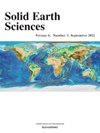沿海含水层的水文地质和电地层学建模:调查系统脆弱性、水力产量潜力和腐蚀性途径
IF 2
4区 地球科学
Q3 GEOSCIENCES, MULTIDISCIPLINARY
引用次数: 0
摘要
本研究利用地质电地层学和水文地质信息来模拟和评估尼日利亚尼日尔三角洲地区主要沿海环境中的地下结构和水文地质特性,为地下水资源管理提供了一种高分辨率的方法。研究区域的选择基于其重要的居住、农业和经济意义,以及对快速城市化和工业活动带来的水文地质挑战的敏感性。与以往单独使用这些方法的研究不同,该研究结合了不同的地电技术,以提高地下表征的准确性。结果描绘了四个不同的地质层,具有特定的电阻率值、厚度和深度,为地下水渗透、储存潜力和污染风险提供了重要的见解。第一层(杂色表土)电阻率值为95.2 ~ 1463.7 Ωm。第二层(砂质粘土)电阻率值为8.8 ~ 2485.1 Ωm。第三层为细砂层,电阻率值为72.5 ~ 1332.7 Ωm。第四层含粗砂,其平均电阻率为525.98 Ωm,表明该层为排水良好的渗透性地层,可作为额外的含水层单元。本研究的一个关键创新是定量评价水文地质参数,包括各向异性系数、横向阻力、纵向电导和地下水产势指数。各向异性系数范围为1.0 ~ 1.78(平均值为1.17),表明贝宁组沉积物侵入最小,以砂质沉积物为主。地下水生产潜力指数在3.14 × 102 ~ 8.1465 × 104 Ωm2范围内变化,突出了含水层潜力显著的区域。纵向电导分析显示,研究区69%的含水层保护系数较低,表明该区域易受污染。另一个新颖的贡献是评估土壤腐蚀性,这对基础设施的寿命有直接影响。结果表明,86%的研究区域无腐蚀,适合长期管道安装,这是地下水评价中很少考虑的因素。该研究还通过将电阻率变化与砂泥质夹层联系起来,提高了对贝宁组的理解,这对地下水运动和污染物输送有重大影响。通过综合电阻率模型、水文地质参数和污染风险评估,本研究为地下水可持续管理提供了一个更全面的框架。此外,本研究为其他具有类似地质和水文环境的地区的类似水文地球物理评估提供了一个强有力的框架。本文章由计算机程序翻译,如有差异,请以英文原文为准。
Hydrogeological and electrostratigraphic modeling of coastal aquifers: Investigating systemic vulnerability, hydraulic yield potential, and corrosivity pathways
This study employed geo-electrostratigraphic and hydrogeological information to model and assess subsurface structure and hydrogeological properties within a major coastal environment in Nigeria's Niger Delta region, offering a high-resolution approach to groundwater resource management. The selection of the study area was predicated on its critical residential, agricultural, and economic significance, as well as its susceptibility to hydrogeological challenges arising from rapid urbanization and industrial activities. Unlike previous studies that utilized these methods independently, this research combined different geoelectrical technologies to enhance the accuracy of subsurface characterization. The results delineated four distinct geo-layers characterized by specific resistivity values, thicknesses, and depths, providing crucial insights into groundwater infiltration, storage potential, and contamination risks. The first geo-layer (motley topsoil) had resistivity values ranging from 95.2 to 1463.7 Ωm. The second layer (sandy clay) exhibited resistivity values ranging from 8.8 to 2485.1 Ωm. The third layer, identified as fine sand, exhibited resistivity values ranging from 72.5 to 1332.7 Ωm. The fourth layer comprised coarse sands and it exhibited a mean resistivity of 525.98 Ωm, indicating a well-drained permeable formation that could serve as an additional aquifer unit. A key innovation of this study was the quantitative assessment of hydrogeological parameters, including anisotropic coefficient, transverse resistance, longitudinal conductance, and groundwater yield potential index. The anisotropic coefficient ranged from 1.0 to 1.78 (mean: 1.17), revealing minimal sediment invasion and confirming the dominance of arenaceous sediments in the Benin Formation. The groundwater yield potential index varied from 3.14 × 102 to 8.1465 × 104 Ωm2, highlighting areas of significant aquifer potential. The longitudinal conductance analysis revealed that 69 % of the study area has low aquifer protectivity, underscoring the region's vulnerability to contamination. Another novel contribution was the evaluation of soil corrosivity, which has direct implications for infrastructure longevity. Results indicate that 86 % of the study area is non-corrosive, making it suitable for long-term pipeline installation, a factor rarely integrated into groundwater assessments. The study alsoadvances understanding of the Benin Formation by linking resistivity variations to arenaceous-argillitic intercalations, and this significantly influences groundwater movement and contaminant transport. By synthesizing resistivity models, hydrogeological parameters, and contamination risk assessments, this research provides a more holistic framework for sustainable groundwater management. Furthermore, this research offers a robust framework for similar hydrogeophysical assessments in other regions with comparable geological and hydrological settings.
求助全文
通过发布文献求助,成功后即可免费获取论文全文。
去求助
来源期刊

Solid Earth Sciences
GEOSCIENCES, MULTIDISCIPLINARY-
CiteScore
3.60
自引率
5.00%
发文量
20
审稿时长
103 days
 求助内容:
求助内容: 应助结果提醒方式:
应助结果提醒方式:


